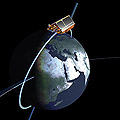|
Coverage: Global where SAR mode is operated
Time period: April 2011 to current date minus one month
Cryosat-2 data products used: ESA Level 1A SAR
Description:
Data from the TU Delft RADS data-base are used.
The process of reducing Level 1A SAR to PLRM and
retracking PLRM to generate a level2 product that can be combined with
the conventional LRM level2 product includes the following steps (to be
carried out 20 times per second):
- Gather 4 bursts of 64 echoes.
- Align them to a common range by phase shifting the
complex power for each of the bins for each echo by a phase shift
equivalent to the change of range compared to the middle one. The
change of range is based on the altitude rate rather than the on-board
tracker information.
- Apply a 1-dimensional FFT to the data in the
frequency direction (128 bins). This creates 256 complex and very noisy
“waveforms”.
- Incoherently average (i.e. average the power) of each
of the 128 bins across the 256 individual waveforms to form a single
Pseudo-LRM waveform at 20-Hz.
- Apply the low-pass filter correction.
- Construct range, significant wave height and backscatter in a meaningful way, consistent with low-rate data.
- Cross-calibrate the conventional and Pseudo-LRM data.
These Pseudo-LRM data have been merged with LRM data and
have been available via RADS since October 2012. Various newer
developments are under implementation but have not been assessed yet.
After retracking, the RADS (Radar Altimeter Database
System) is used to add or update all the commonly used geophysical
corrections and then distributed to a multitude of users.
<-- Data
Home
|

